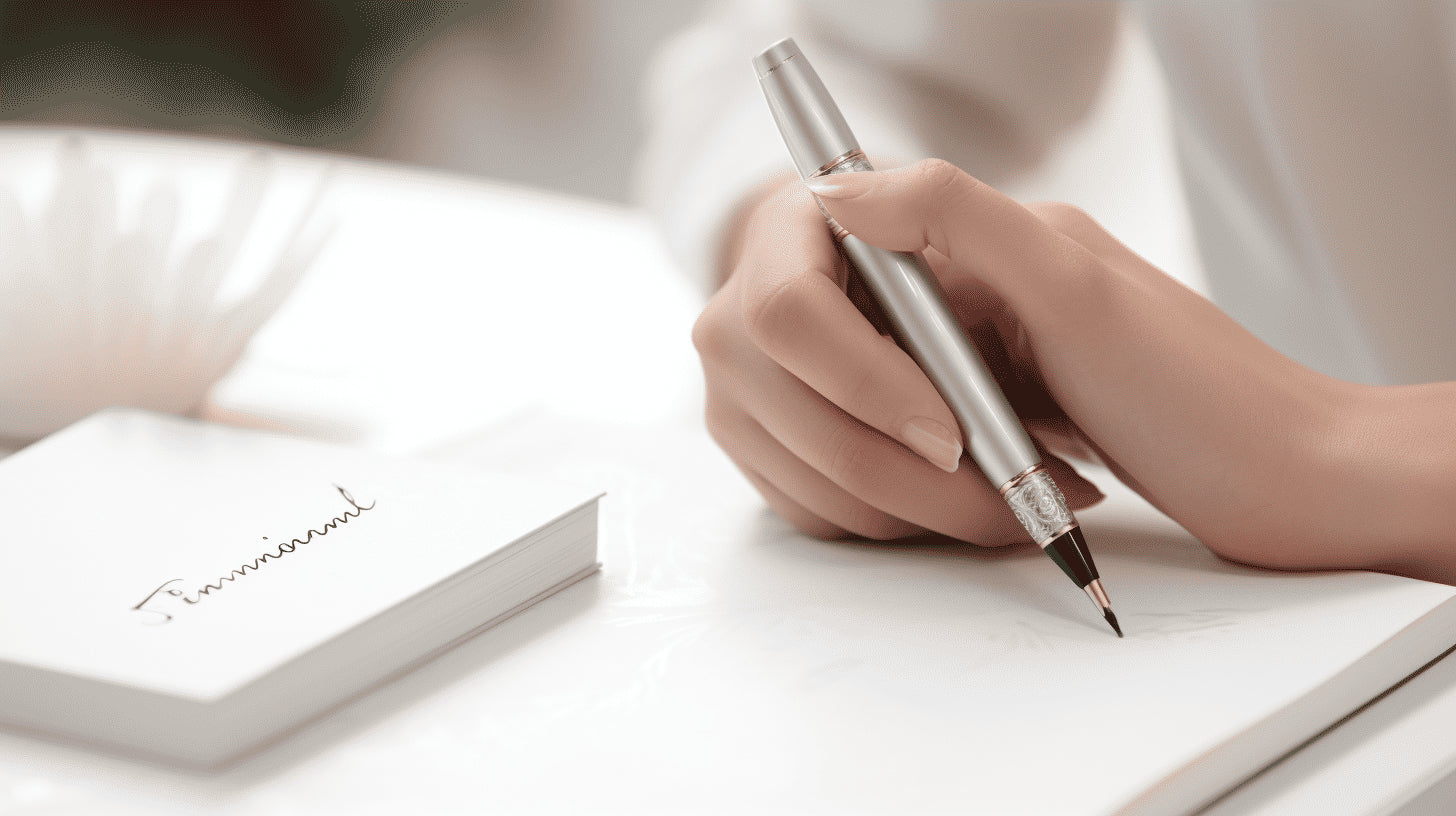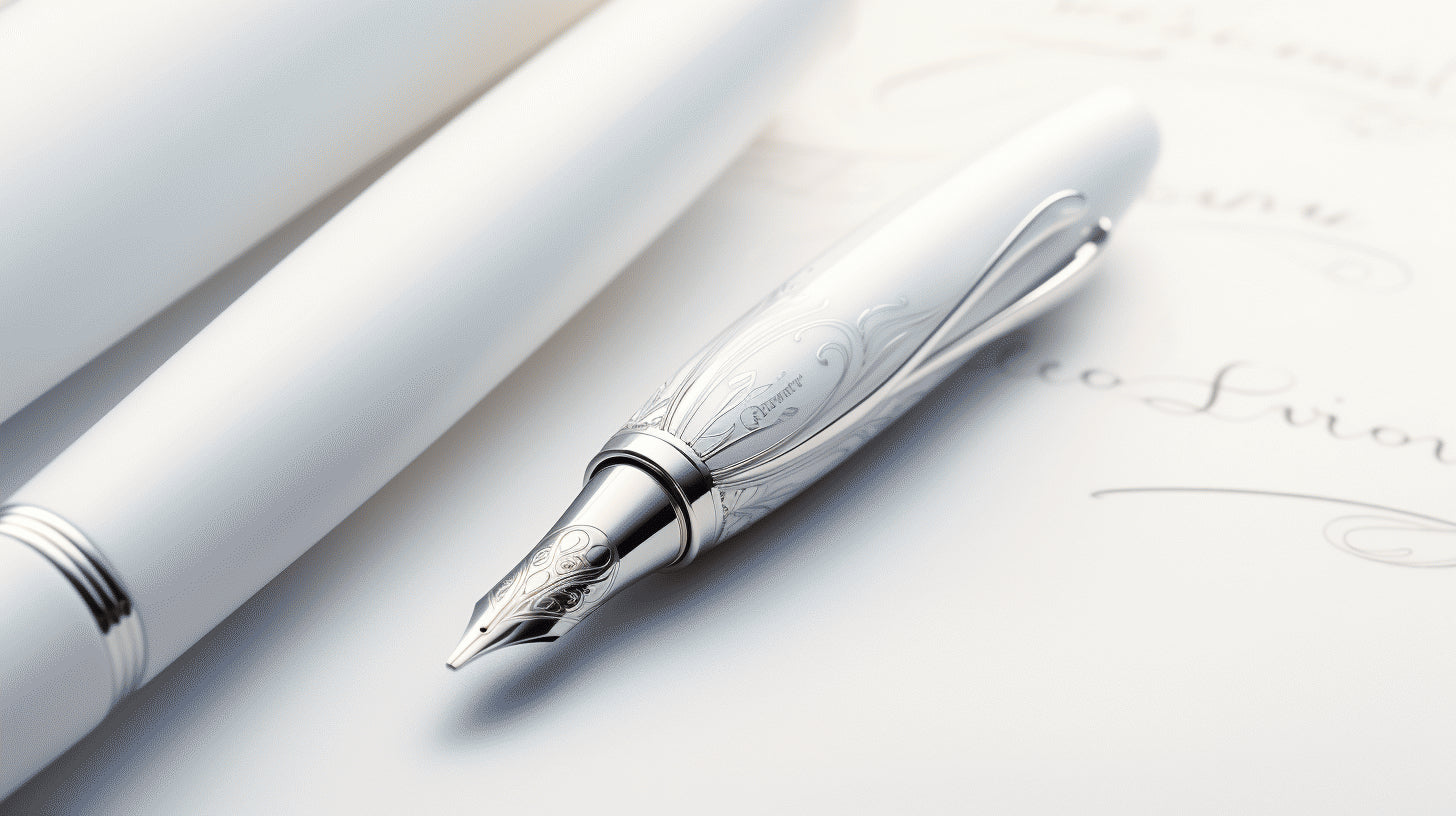
Elevate Your Writing Experience: Rediscover the Pleasure of Fountain Pens
Do you remember the thrill of writing with a fountain pen? The smooth glide of the nib on the paper, the elegance of the ink flowing effortlessly, and the timeless beauty of the writing instrument itself. In a world dominated by digital devices, the art of writing with a fountain pen has been somewhat forgotten. However, it's time to rediscover the pleasure of this classic writing tool and elevate your writing experience to a whole new level.
Fountain pens have a rich history dating back centuries and have evolved into a symbol of sophistication and refinement. From their humble beginnings to their current resurgence in popularity, fountain pens offer a unique writing experience that can't be replicated by any other writing instrument.
In this article, we will explore the history and evolution of fountain pens, delve into the specific features that make them stand out, discuss the current market scenario, examine the economic impact of the fountain pen industry, and even speculate on the future of fountain pens. So, grab your favorite notebook, fill up your inkwell, and let's dive into the world of fountain pens. It's time to reignite your love for writing and rediscover the joy of using a fountain pen.
History and Evolution of Fountain Pens
When it comes to the evolution of writing instruments, fountain pens hold a special place in history. These timeless tools have seen centuries of innovation and refinement, transforming the act of writing into an art form. From their humble beginnings to the modern designs we see today, the history of fountain pens is as captivating as the ink they deliver.
Ancient Origins
The concept of a pen with a reservoir of ink dates back thousands of years, with early examples emerging in ancient civilizations such as Egypt and Mesopotamia. These early incarnations of fountain pens consisted of reed or bamboo shafts with a hollow center to hold ink, bringing the convenience of portable writing to the masses.
The Renaissance and Beyond
Fast forward to the 17th century, and we find the dawn of the modern fountain pen. Inventors like Petrache Poenaru, a Romanian, and Charles-Henri Labrosse, a Frenchman, added a metal nib to the design, allowing for a more controlled and consistent flow of ink. These early versions were primarily used by scholars and nobility, combining functionality with a touch of elegance.
19th Century Innovations
The 19th century marked a turning point in the evolution of fountain pens, driven by inventors like Lewis Waterman and George Parker. Waterman's breakthrough was the integration of an air hole to regulate ink flow, preventing leaks and improving performance. Parker, on the other hand, introduced the concept of a replaceable ink reservoir, making it possible to carry a larger amount of ink for extended writing sessions. These innovations paved the way for the widespread adoption and popularity of fountain pens.
Modern Advancements
In the 20th century, fountain pen designs continued to evolve with the introduction of materials like celluloid, metal alloys, and plastics. Companies like Montblanc, Sheaffer, and Cross became synonymous with quality and craftsmanship, producing fountain pens that were not only functional but also coveted luxury items.
Today, fountain pens are experiencing a resurgence in popularity, thanks to their timeless appeal and the unique writing experience they offer. Modern advancements in manufacturing techniques have made fountain pens more accessible than ever, with a wide range of styles, materials, and price points to suit every writing enthusiast.
From vintage gems to contemporary masterpieces, the evolution of fountain pens is a testament to human ingenuity and the desire to create something beautiful and functional. So, whether you're a seasoned collector or a novice writer exploring the world of fountain pens, take a moment to appreciate the rich history behind these remarkable instruments.
To delve deeper into the fascinating evolution of fountain pens, check out this article at The Fountain Pen Journal.
The Current Fountain Pen Market Scenario
The fountain pen market is thriving, with a steady increase in demand and sales. Over the years, fountain pens have become more than just writing instruments; they have transformed into a symbol of luxury and elegance. Let's take a closer look at the current fountain pen market scenario.
According to recent reports, the fountain pen market size was valued at USD 929.0 million in 2021, and it is expected to expand at a CAGR of 2.51%. This indicates a positive growth trajectory and a strong market presence for fountain pens[1].
The global fountain pen market, in particular, was valued at USD 955.94 million in 2022. This highlights the global appeal and widespread popularity of fountain pens[2]. Additionally, the fountain pen industry reportedly sells $1 billion pens annually, showcasing its lucrative nature[3].
One significant aspect of the fountain pen market is the luxury pen segment. With their exquisite craftsmanship and premium materials, luxury pens command a higher price point and cater to discerning customers who appreciate the finer things in life. It's no wonder that the global luxury pen market is estimated to reach a value of USD 3,800 million by 2031[4].
These figures and predictions underscore the fact that fountain pens continue to hold their allure in an increasingly digital world. In an age of keyboards and touchscreens, there is something special about the tactile experience and artistry that comes with using a fountain pen.
So whether you're a seasoned collector, an avid writer, or someone looking to add a touch of elegance to their daily routine, the fountain pen market offers an array of options to suit your preferences and style.
In the following sections, we will delve into various aspects of the fountain pen market, including its history, types of fountain pens, top brands, and factors to consider when buying a fountain pen. So, let's dive in and explore the world of fountain pens together.
[1] Source
[2] Source
[3] Source
[4] Source
Specific Features of Fountain Pens
Fountain pens are more than just a writing instrument; they offer a unique and enjoyable writing experience. With their timeless appeal and precise craftsmanship, fountain pens have become a favorite among writing enthusiasts and collectors alike. In this section, we will explore some of the standout features that make fountain pens so special.
Limitless Ink Colors
One of the most exciting aspects of using a fountain pen is the wide range of ink colors available. Unlike ballpoint or rollerball pens, which typically come in a limited selection of colors, fountain pens offer an almost endless variety. From vibrant blues and greens to deep purples and rich browns, there is a fountain pen ink color to suit every mood and style.
Variety of Weights and Lengths
Fountain pens come in a range of weights and lengths, allowing users to find the perfect pen that suits their preferences. Whether you prefer a lightweight and sleek pen that's easy to handle, or a heftier pen that provides a more substantial writing experience, there is a fountain pen out there for you.
Less Pressure Required
Compared to other types of pens, fountain pens require much less pressure to write. The ink flows smoothly onto the paper, eliminating the need to press down forcefully. This not only reduces hand fatigue but also translates into a more comfortable and effortless writing experience.
Customizable Nib Sizes and Shapes
One of the standout features of fountain pens is their customizable nibs. The nib is the metal tip of the pen that comes into contact with the paper. Fountain pens offer a range of nib sizes, allowing users to choose the writing thickness that suits their preference. From fine and precise lines to broader and more expressive strokes, fountain pens offer versatility and customization options that other pens simply can't match.
Eco-friendly
In today's environmentally conscious world, using a fountain pen can be a sustainable choice. Unlike disposable pens, which contribute to plastic waste, fountain pens are refillable. This means you can simply replace the ink cartridge or use a converter to fill the pen with bottled ink. By opting for a fountain pen, you can reduce your environmental impact and enjoy a greener writing experience.
Improves Handwriting
Using a fountain pen encourages good penmanship habits and can lead to improvements in handwriting. The smooth flow of ink and the need for a lighter touch can help develop a more controlled writing style. Fountain pens promote mindful writing, forcing the writer to slow down and focus on each stroke. Over time, this can result in more legible and professional-looking handwriting.
Popular Among Sketchers
Fountain pens have gained popularity among artists and sketchers for their unique qualities. The portability and refillability of fountain pens make them ideal for capturing art on the go. Additionally, fountain pens offer varied line quality, allowing artists to experiment with different techniques and create dynamic and expressive drawings.
In conclusion, fountain pens offer a plethora of features and benefits that set them apart from other writing instruments. From the wide range of ink colors to the customizable nibs and the eco-friendly nature, fountain pens have a timeless appeal that attracts both writing enthusiasts and artists. Whether you're writing a heartfelt letter or creating a work of art, a fountain pen can elevate your experience and leave a lasting impression.
For more information on the allure of artisan fountain pens, you can check out this Allure of Artisan Fountain Pens article.
Economic Impact of the Fountain Pen Industry
The fountain pen industry has proven to be a significant contributor to the global economy, generating substantial revenue and exhibiting strong growth potential. This beloved writing instrument has captured the hearts of individuals around the world, becoming not only a tool for communication but also a symbol of sophistication and elegance.
According to industry reports and market data, the pens segment accounted for approximately 35.8% of global revenue in 2022[1]. This showcases the immense popularity of fountain pens among consumers and highlights their crucial role in the overall pen industry.
In 2014, the pen industry generated worldwide revenue of $16.2 billion, with projections showing steady growth to reach $20.2 billion by 2019[2]. This anticipated increase in revenue reflects the growing demand for pens, including fountain pens, and underscores the economic significance of this industry.
The fountain pen market, in particular, is expected to experience a compound annual growth rate (CAGR) of 12.7%[3]. This impressive growth rate further emphasizes the industry's potential to contribute to the global economy.
It is important to note that the economic impact of the fountain pen industry extends beyond the revenue generated by manufacturers and retailers. This industry also supports numerous jobs in manufacturing, distribution, marketing, and retail, providing employment opportunities for individuals across the globe.
In conclusion, the fountain pen industry holds a prominent position in the global economy, generating substantial revenue and exhibiting robust growth. Its impact goes beyond financial figures, as it contributes to job creation and serves as a beloved writing instrument for individuals worldwide.
[1]: Source
[2]: Source
[3]: Source
The Future of Fountain Pens
Fountain pens, once the epitome of sophisticated handwriting, seemed to have faded into obscurity with the advent of technology. However, much to the surprise of many, these elegant writing instruments are experiencing a remarkable revival in the digital age. In this article, we will explore the reasons behind the resurgence of fountain pens and why they are becoming increasingly popular among writers and pen enthusiasts.
A Return to Authenticity
In a world dominated by digital communication, people are craving authenticity and a connection to the past. Fountain pens offer a tangible and tactile writing experience that cannot be replicated by typing on a keyboard or tapping on a touchscreen. The smooth flow of ink and the deliberate act of putting pen to paper create a connection between the writer and their words, allowing for a more intimate and personal expression.
Timeless Elegance
Fountain pens are not just tools for writing; they are pieces of art that exude elegance and style. The craftsmanship and attention to detail that go into creating these pens make them coveted collector's items. From the intricate designs on the nibs to the luxurious materials used for the barrels, fountain pens are a testament to the beauty of traditional craftsmanship.
Enhanced Writing Experience
One of the key reasons behind the resurgence of fountain pens is the unparalleled writing experience they offer. Unlike ballpoint pens that require pressure to produce ink, fountain pens glide effortlessly on paper, resulting in less fatigue and a smoother writing experience. The wide variety of nib sizes allows writers to customize their writing style, whether they prefer bold and expressive strokes or delicate and precise lines.
Sustainability and Longevity
In an age where environmental consciousness is gaining prominence, fountain pens offer a sustainable alternative to disposable pens. Instead of contributing to plastic waste, fountain pens can be refilled with ink cartridges or by using converters to fill them from ink bottles. Additionally, fountain pens are built to last. With proper care and maintenance, a high-quality fountain pen can be passed down from generation to generation, becoming a cherished heirloom.
Conclusion
In conclusion, fountain pens offer a timeless and elegant way to elevate your writing experience. The history and evolution of fountain pens showcase their enduring appeal, while their unique features set them apart from other writing instruments. From their limitless ink colors to the variety of nib sizes and shapes, fountain pens offer a level of customization that suits every writer's preferences.
Not only do fountain pens provide a superior writing experience, but they also have a positive impact on the environment. With less pressure required and the ability to refill them with ink, fountain pens are a more sustainable choice compared to disposable pens.
The future of fountain pens looks bright, with new innovations and designs continuously being introduced. Whether you're a student, professional, or an enthusiast, fountain pens will continue to be the go-to choice for those seeking a refined and pleasurable writing experience.
To truly indulge in the art of writing, consider exploring the exquisite wooden fountain pens from Wood Fountain Pens. Handcrafted with precision and attention to detail, these pens are a testament to the beauty and allure of writing instruments. Visit woodfountainpens.com to discover their exceptional collection and rediscover the joy of writing with a Wood Fountain Pen.
Frequently Asked Questions
-
What is a fountain pen and how does it work?
A fountain pen is a writing instrument that uses liquid ink and a nib to write on paper. It works by capillary action, where the ink is drawn from the reservoir (usually in the barrel of the pen) through a feed and onto the paper.
-
Why should I use a fountain pen instead of a ballpoint pen?
Using a fountain pen can offer a more enjoyable writing experience. It provides greater control, a smoother and more consistent flow of ink, and can reduce hand fatigue, making it ideal for longer writing sessions. Additionally, fountain pens can add a touch of elegance to your writing.
-
Are fountain pens expensive?
Fountain pens can range in price from affordable to quite expensive, depending on the brand, materials used, and craftsmanship. There are budget-friendly options available for those new to fountain pens, as well as high-end luxury pens for collectors or enthusiasts.
-
Do fountain pens require special ink?
Fountain pens do require specific fountain pen ink, which is water-based and designed to flow smoothly through the pen's nib. It is important to avoid using regular ink or other inks not specifically made for fountain pens, as they may clog the pen or cause damage.
-
Are fountain pens suitable for everyday use?
Absolutely! Fountain pens are versatile and can be used for everyday writing tasks such as note-taking, journaling, and general writing. They can bring a touch of elegance and joy to your daily writing routine.







Leave a comment
This site is protected by hCaptcha and the hCaptcha Privacy Policy and Terms of Service apply.